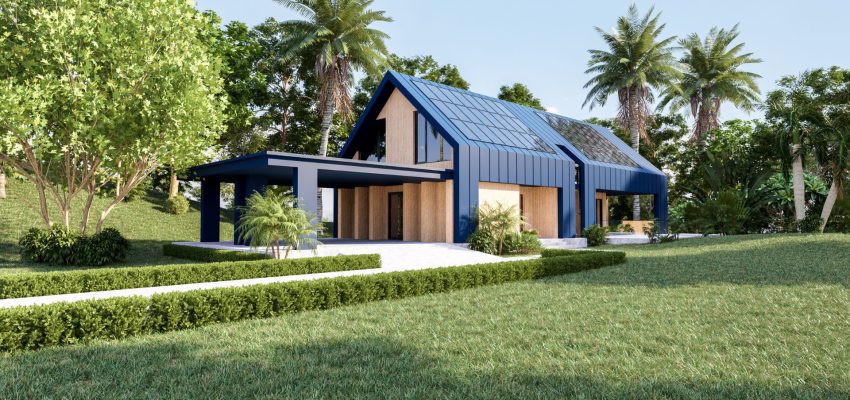
A Beginner’s Guide to Sustainable Home Design: 4 Essential Steps
Are you thinking about renovating your sustainable home and, by happy coincidence, you’re also passionate about the environment? You’re in the right place! This guide will walk you through four key steps to a sustainable home design that you can’t imagine.
You’ll learn about passive house principles and durability, all while using sustainable and recycled materials.
It’s not just about saving the planet; it’s about creating a space where you truly belong.
So, let’s roll up our sleeves and start your green building eco-friendly dream home!
Understanding Sustainable Home Design

As a future homeowner, you’re on the right path to understanding sustainable home design. It’s a topic that can truly transform your living space. It’s all about using resources strategically to create a home that’s not only comfortable but also kind to our planet.
There’s a real sense of community in the world of sustainable design, and you’re now part of it. You don’t have to break the bank either. By choosing sustainable materials and technologies, you can help reduce your home’s energy consumption, which will save you money in the long run. It’s a win-win situation.
Knowledge is power, so equip yourself with the know-how to make smart, sustainable choices. Ready for the next step? Let’s delve deeper into what a sustainable home really is.
What is a Sustainable Home?
A sustainable home is one designed to minimize its environmental impact by using energy-efficient technologies and sustainable materials.
It’s not just about being kind to the environment; it can also offer you significant savings on your energy bills.
Have you ever considered the benefits of such design or explored the world of prefabricated homes?
Benefits of Sustainable Home Design
With sustainable home design, you’ll see several benefits, such as reduced energy costs and a smaller carbon footprint. It’s more than just being environmentally friendly; it’s about creating a home that grows with you. A sustainable home isn’t just a structure. It’s a living, breathing entity, a reflection of you and your commitment to our planet.
Let’s explore some of the benefits:
Lower operating costs: Efficient appliances save you money.
Improved indoor air quality: Green materials don’t emit hazardous fumes.
Increased home value: Eco-friendly homes are in high demand.
Positive environmental impact: You’re doing your part to combat climate change.
Read also – 10 Must-Have Features in Modern Home Designs
Exploring Prefabricated Homes

You’re probably wondering, ‘What are prefab homes?’
Simply put, they’re sustainable houses built from modules constructed off-site, then shipped and assembled at your location.
With advantages like cost-effectiveness and reduced environmental impact, it’s no wonder brands are stepping up to innovate in this area.
What are Prefab Homes?
In your quest for sustainable living, you might’ve heard of prefab homes, but what exactly are they? They’re practical, cost-effective dwellings, crafted off-site and then transported to their permanent location.
- Designed with precision, reducing waste
- Constructed in controlled environments
- Installed swiftly to save time
- Built with sustainable materials
Advantages of Prefab Homes
Not only do prefab homes provide numerous financial benefits, but they also offer a great deal of flexibility in terms of design and customization. You’re not bound by traditional constraints.
They’re built using sustainable materials, reducing your carbon footprint. And, you’re part of a growing community embracing this eco-friendly lifestyle.
Incorporating Passive House Principles and Ventilation

Are you considering incorporating passive house principles?
This approach, which entails a specific set of design features, can significantly reduce your home’s energy demand. It also includes ventilation, a crucial element for maintaining air quality and temperature control.
Let’s explore some notable passive house designs and see how they achieve high efficiency.
What is a Passive House?
In simplest terms, a passive house is one that’s designed to be energy efficient, using up to 90% less heating and cooling energy than conventional homes. You’re not just cutting costs, you’re also doing your part for the environment.
Here’s what makes a house passive:
- Superior insulation that keeps the heat in during winter and out during summer.
- Energy recovery systems that recycle and reutilize the heat produced within the house.
- High-performance windows that trap heat or reflect it, depending on the season.
- Airtight construction that eliminates drafts and thermal bridges.
You’re reducing your carbon footprint while saving on energy bills. It’s strategic, economical, and most importantly, it’s sustainable.
Features of a Passive House
You’ll notice that a passive house boasts superior insulation and energy recovery systems. These features minimize heat losses, making the house warm in winter and cool in summer without you breaking the bank on energy bills.
But it also includes high-performance windows and airtight construction. These additional features further contribute to the energy efficiency of the house.
You’re probably wondering about the cost. Yes, it’s an upfront investment, but it’s one that pays for itself in the long run. Imagine, you’re not just saving money, you’re part of a community committed to reducing environmental impact.
Passive houses use sustainable materials, cutting-edge technologies, and clever design strategies. This combination of elements makes them a smart choice for anyone seeking a cost-effective, eco-friendly lifestyle.
Notable Passive House Designs
Before we delve deeper into the subject, let’s take a moment to discuss some notable passive house designs. By the end of this section, you’ll appreciate how they’ve successfully incorporated energy-efficient principles.
The Larch House in the UK, the first zero-carbon, passive house in the country, is a testament to the potential of strategic, cost-effective design.
Germany’s Kranichstein Passive House, the world’s first, remains a shining example of sustainable innovation.
The Passive House in the Woods, located in Wisconsin, USA, is a single-family home that demonstrates how sustainable materials can create a comfortable, modern living space.
The Brussels Greenbizz, an industrial project, shows that passive design isn’t limited to residential buildings.
Ensuring Sustainability and Durability
To ensure your home’s sustainability and durability, it’s crucial to minimize waste during construction and select resilient materials.
For instance, reclaimed wood or recycled steel are both cost-effective and eco-friendly options.
Looking at examples of sustainable and durable homes can also provide valuable insights for your own project.
Reducing Waste in Home Construction

In your quest for a greener home, it’s crucial to understand that reducing waste during construction can significantly impact overall sustainability. By implementing eco-friendly strategies, you’re not just saving the planet; you’re also saving money and creating a healthier living space.
Consider:
- Using sustainable materials, like recycled glass or reclaimed wood, cuts down on waste and decreases your carbon footprint.
- Opting for energy-efficient appliances and technologies. They may cost more upfront, but they’ll save you money in the long run.
- Implementing a waste management plan during construction. It’s an easy way to make sure that waste is properly sorted and disposed of.
- Choosing architects or contractors who are knowledgeable about and committed to sustainable practices.
Choosing Durable Materials
You’re on the right path by focusing on sustainable practices, and now it’s time to choose durable materials that can withstand the test of time. Let’s look at some options:
| Material | Sustainability | Durability |
| Bamboo | High | Moderate |
| Recycled Steel | Moderate | High |
| Cob | High | Moderate |
Bamboo is a fast-growing, renewable resource. Recycled steel is energy-efficient and withstands weather extremes. Cob, a mix of clay, sand, and straw, is inexpensive, locally sourced, and has a long lifespan. All demonstrate cost-effectiveness and durability. Remember, your choices matter as they’re a reflection of your commitment to sustainable living. Next, we’ll explore examples of sustainable and durable homes, so you can see these materials in action.
Read also – Selecting Durable New Home Building Materials
Examples of Sustainable and Durable Homes
Let’s dive into some examples of sustainable and durable homes that’ll surely inspire your next design project. These homes not only stand the test of time, but they’re also kinder to our planet. They’ll make you feel part of a larger community striving for a greener future.
The Hobbit House in Wales: Built with natural materials, it’s a perfect example of a low-impact, energy-efficient dwelling.
The Slip House in London: This home uses solar panels and ground source heat pumps, making it energy self-sufficient.
The Green Orchard House in Australia: A home that utilizes its surroundings for natural light and temperature control.
The ZeroHouse in New York: An autonomous, zero-waste home with solar panels and a rainwater collection system.
They’re more than just homes; they’re a lifestyle choice.
Final Thoughts
As you embark on your own eco-friendly odyssey, remember that sustainable home design is more than just a trend—it’s a lifelong commitment to our planet.
By incorporating passive house principles and focusing on sustainability and durability, you’re not just building a house; you’re crafting a love letter to Mother Earth.
It’s your chance to be a modern-day Noah, saving the world one eco-conscious decision at a time.
It’s a challenge, but one worth taking.
Let’s make our homes part of the solution.
Frequently Asked Questions
How Much Does It Typically Cost to Design a Sustainable Home?
Costs can vary greatly; you might spend between $10,000 to $200,000. It’s not cheap, but you’re investing in sustainability. You’re choosing smart, earth-friendly materials and technology. You’re part of the solution.
Can I Remodel My Existing Home to Make It More Sustainable?
Absolutely, you can remodel your existing home to make it more sustainable. It’s a cost-effective strategy, using sustainable materials and technologies. It’s not just about saving money, but also being part of the solution.
How Long Does It Take to Fully Design and Build a Sustainable Home?
Designing and building a sustainable home can take 1-2 years. You’re creating a space that’s not just eco-friendly, but also homey. It’s a journey worth taking for the planet and your comfort.
Can Sustainable Homes Be Designed in Any Climate or Geographical Location?
Yes, you can design sustainable homes in any climate or location. It’s all about selecting the right materials and technologies to suit your environment. You’re not limited by geography, but enhanced by its unique potentials.
What Are Some of the Challenges and Obstacles That May Arise When Designing a Sustainable Home?
You’ll face hurdles like higher upfront costs, sourcing eco-friendly materials, and local building codes. But don’t worry, overcoming these challenges will make your sustainable dream home even more of a triumph.
